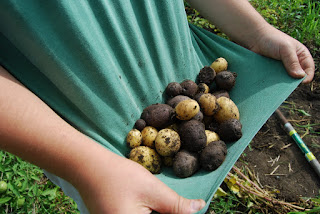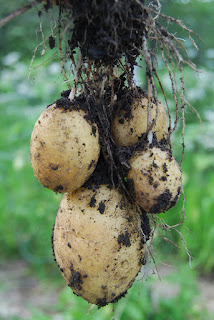
Despite the cool weather and gossip of a tomato blight this summer , we have had much success with our heirloom slicer tomatoes. We've been juicing them, eating them as appetizers, putting them in salad, and giving them away like hotcakes to keep up. However, we're not looking forward to this stopping; we are quite enjoying ourselves. Moments of quiet and calm are few and far between as the school years picks up. Our tomatoes force us to take a step back and enjoy the outdoors and the remainder of summer.
When we choose tomato seeds, there are a few staples, including Aunt Ruby's German Green Tomato. These are large, beefsteak tomatoes. When they are soft to the touch, they're ready to be picked. We find the taste to be mellow and smooth with sweet accents.
Another beefsteak staple is the Brandywine Tomato. Like the name implies, these are rose-colored. Also very large, these make a great slicer to be eaten alone. When we taste-tested all of our tomatoes to compare them last evening, we thought this one had the most intense tomato flavor.
A new variety that we tried this year, but will definitely become a staple is the Nyagous Tomato. These tomatoes have been blemish-free and perfectly round. They are a deep wine-red color and are very sweet, maybe even a bit smokey, in flavor. Yum!
Along the same lines as the Nyagous, is the Black from Tula Tomato. These tomatoes look very similar to the Nyagous, and if they were any smaller, they might be confused with the Nyagous. They're a Russian heirloom, meaning that they produce earlier because they have been bred to have a shorter growing season. Very complex flavor. It reminded us of a good wine!
Our next tomato variety, we have nicknamed the Packer Tomato. It is the Green Zebra ~ green and yellow, this slightly smaller tomato packs a nice tangy punch! Very refreshing, especially on a hot summer day with a glass of white wine.
Our last variety, sure to become a staple in our garden, is the Striped Cavern. We bought this variety on a limb, but are so happy that we did. This tomato is perfect for stuffing. We've had quite an adventurous summer, stuffing these with whatever cheeses and herbs we have had available.
Striped Cavern
Cheese- Stuffed Striped Caverns





























